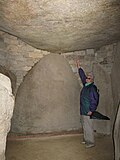
The Locmariaquer megaliths are a complex of Neolithic constructions in Locmariaquer, Brittany. They comprise the elaborate Er-Grah tumulus passage grave, a dolmen known as the Table des Marchand [1] and "The Broken Menhir of Er Grah", the largest known single block of stone to have been transported and erected by Neolithic people.

















